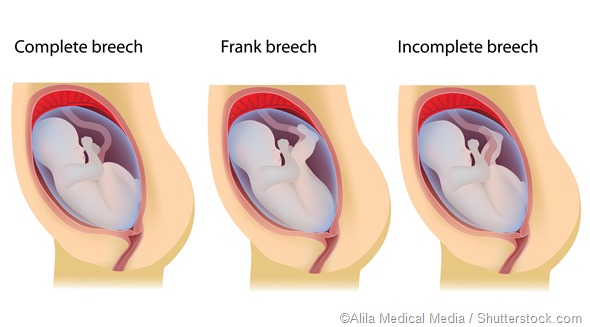Breech presentation is common in about 15% of pregnancies at 29 to 32 weeks. Although breech position is common in the first two trimesters of pregnancy when the baby is more mobile, it is considered abnormal during late pregnancy. About 25% of breech babies undergo version and settle down in a head-first position by the time labor starts.
If a breech baby doesn’t turn naturally, the doctors might try turning the fetus through a process called external cephalic version. Here, an obstetrician applies pressure on the mother’s abdomen and tries to turn the baby into a head-first or cephalic position.
This procedure is successful in about 50% of breech babies. If this doesn’t work, then doctors will have to prepare for a breech birth. A caesarean section is considered the safest method to deliver a breech baby as there are some risks involved in vaginal delivery of a breech baby.
Complications with vaginal breech delivery
Vaginal breech birth is complicated because during a head-down vaginal delivery the fetal head is delivered first. Being the largest part of a baby, the head expands the mother’s pelvis enough for the rest of the fetal body parts to be delivered.
However, in the case of a breech baby, the pelvis or hips are delivered first and the mother’s pelvis may not stay large enough for the fetal head that follows. The baby’s head can get stuck in the birth canal, which results in serious complications leading to injury or death. Vaginal breech birth can also damage or block the umbilical cord, cutting off oxygen supply to the baby.
According to the Royal College of Obstetricians and Gynaecologists, vaginal breech delivery must be avoided in the following situations:
- Footling breech – feet of the fetus are below its bottom
- Peculiar position of the fetus, e.g., neck of the baby is tilted back
- Large babies weighing over 3.8kg
- Small baby weighing less than 2kg
- Narrow pelvis with less space for the fetus to safely pass through the birth canal
- Caesarean delivery in previous pregnancy
- Pre-eclampsia
- Low-lying placenta
Some serious complications related to vaginal breech delivery are listed below:
- Trauma due to extended arm or head
- Placental detachment
- Injury to abdominal organs
- Broken fetal neck
- Umbilical cord prolapse leading to asphyxia
Vaginal breech delivery can still be safely performed by a skilled physician in case of a complete breech or bottom-first position of the fetus, if adequate pelvic room is available and no previous C-section delivery due to breech.
C-section (caesarean) breech birth
A caesarean section is the only safe option in the case of double footling breech, small or narrow pelvis and a very large fetus. Planned caesarean section for breech birth has been found to lower perinatal and neonatal death rates, lower short-term neonatal morbidity rates and reduce 5 minutes Apgar scores, as compared to vaginal breech birth.
Decisions regarding the best mode of delivery for breech babies are made on an individual basis. In the case of women with breech presentation going into preterm labor, the recommended practice is to perform an emergency C-section. However, in case of fetal death inside the uterus or high maternal risk due to C-section, induction of labor and vaginal delivery is recommended. In modern clinical practice, C-section is recommended for a transverse baby regardless of whether the baby is alive or dead in the womb.
Some women go into labor after a C-section is planned. In such cases, depending on how close the baby is to being born, the doctor makes a decision whether or not to proceed with the C-section. In some cases, if the baby is too close, a vaginal breech birth may be a safer alternative.
Review by Yolanda Smith, BPharm
References:
- http://www.nhs.uk/conditions/pregnancy-and-baby/pages/breech-birth.aspx\
- https://www.nlm.nih.gov/medlineplus/ency/patientinstructions/000623.htm
- https://thewomens.r.worldssl.net/images/uploads/downloadable-records/clinical-guidelines/breech-management-of.pdf
Further Reading
- All Pregnancy Content
- Early Signs of Pregnancy
- Is it Safe to Exercise During Pregnancy?
- Pregnancy: 0-8 weeks
- Pregnancy: 9 – 12 weeks
Last Updated: Aug 23, 2018

Written by
Susha Cheriyedath
Susha has a Bachelor of Science (B.Sc.) degree in Chemistry and Master of Science (M.Sc) degree in Biochemistry from the University of Calicut, India. She always had a keen interest in medical and health science. As part of her masters degree, she specialized in Biochemistry, with an emphasis on Microbiology, Physiology, Biotechnology, and Nutrition. In her spare time, she loves to cook up a storm in the kitchen with her super-messy baking experiments.
Source: Read Full Article